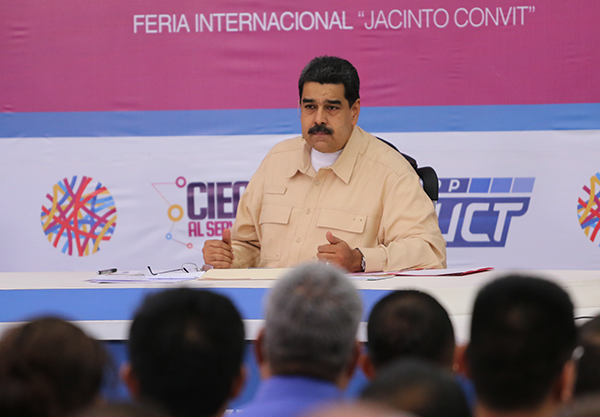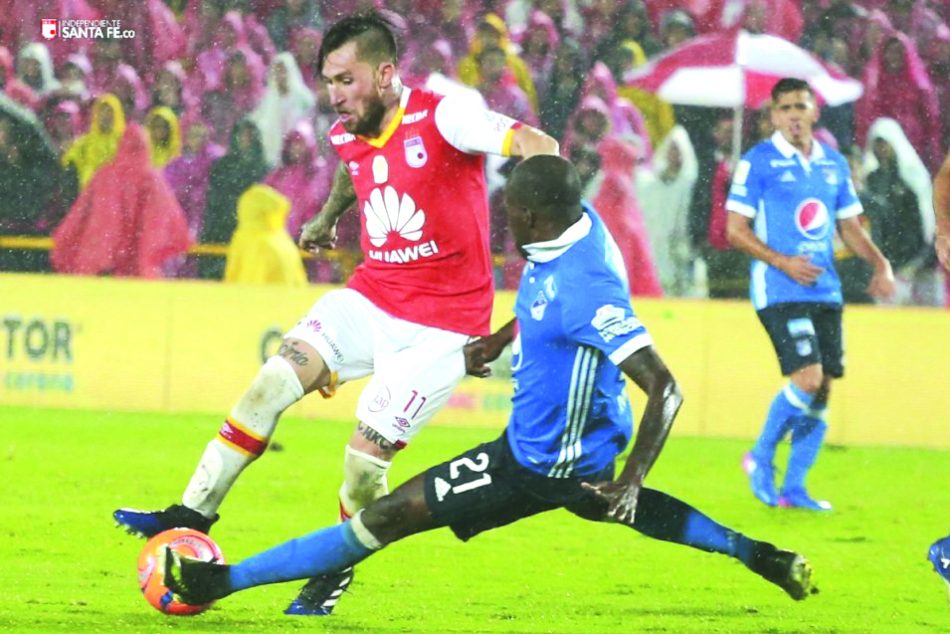The continent’s biggest sporting event is here and Colombians have high hopes, despite the opening game defeat. We look at the history of the tournament, Colombia’s chances and some fun facts thrown in to boot!
Colombian history in the Copa AméricaThe 44th edition of the Copa América has kicked off. Colombia, now making their 20th appearance, are in the hunt for their second title. The Bogota Post looks back at Colombia’s history in the tournament. By Juan Camilo Giraldo & Freek Huigen |
1945 – Chile: First participationMade up of top players from the team of the moment, Junior de Barranquilla, and managed by their coach, Roberto Melendez – whose name still adorns the main stadium in Barranquilla – Colombia finished in fifth place and recorded their first ever win as a national team. The decision to send Colombia’s best club team, rather than a national team made up of the best players, generated controversy. According to Caracol the Colombian media was filled with derogatory comments on the day of their first match. Despite the 3-0, 7-0, 2-0 and 9-1 defeats, the 3-3 draw with Bolivia and the 3-1 victory over Ecuador were celebrated on the coast, although the rest of the country wasn’t quite as positive. |
1975: Violence in Paraguay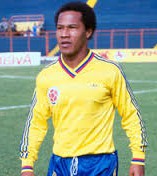 Willington Ortiz The cup leaves behind its old name ‘South American Championship’ and takes on the moniker of the Copa América. With no fixed venue, the games were played in all the participating countries throughout the year. The team was captained by goalkeeper Efraín ‘Caimán’ Sánchez, who also led Colombia in their first World Cup appearance in 1962. The star of the team was striker Willington Ortiz, who to this day is still dubbed the best ever Colombian player by those who’ve seen him play. Colombia faced Paraguay – feared for their ruthless style – in the group stages. They played the deciding match away in Asuncion, but play was suspended after the 43rd minute. Paraguay had dominated the first half, until Colombia’s José Ernesto Díaz scored a textbook surprise goal. The game turned ugly as both local police and players hit out at the away team. Chaos ruled with the Paraguayan goalkeeper chasing Díaz and the rest of the home team physically attacking their opponents. The South American Football Federation gave the points to Colombia, who went on to the finals after ousting reigning champion Uruguay in the semis. The finals against Peru came down to a decider in Caracas after both teams won their home legs. A 1-0 victory gave Peru the title. |
1987 – Argentina: Start of the dream team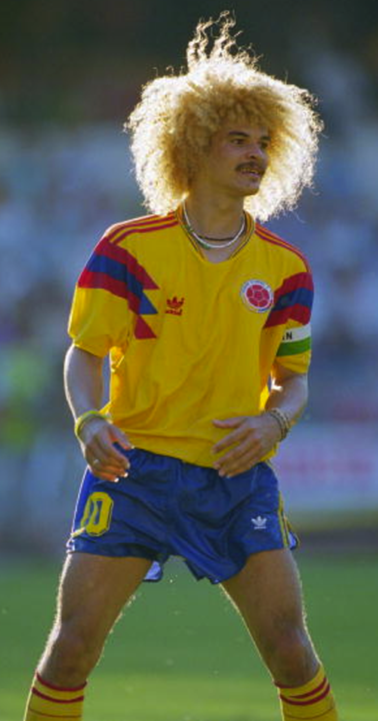 Carlos ‘El Pibe’ Valderrama This year’s Copa saw the birth of a completely new team – coach Francisco Maturana had high hopes for the then little known names like Rene Higuita, Leonél Álvarez, Andrés Escobar and Carlos ‘El Pibe’ Valderrama. The big favourite was World Cup title holder Argentina, with Diego Armando Maradona, closely followed by Paraguay. But Colombia were undaunted – they beat Paraguay 3-0 in the group stage – guided by a brilliant Valderrama and top goalscorer Arnoldo Iguarán. Chile proved too strong in the semi final, beating the young hopefuls 2-1 and pitting Colombia against the home side Argentina for third place. The locals had just suffered an embarrassing defeat against Uruguay and everything was set for Maradona to make up for that, but Valderrama had different ideas. ‘El Pibe’ was very much the game maker – setting up both goals that were scored by Gómez and Galeano. A goal from Caniggia made it 2-1, but it wasn’t enough for the Argentines. Praised throughout South America, Colombia had made their mark on international football. |
1993 – Ecuador: The golden generationUntil last year’s World Cup in Brazil, the heady year of 1993 was seen as the height of Colombian football. It saw a heavy rivalry with Argentina – first in the group stages and then in the semi finals. The Argentines were down a star player as Maradona had been suspended for failing a drugs test. Both sides scored in the first five minutes of the match. The rest of the game saw a lot of kicking and fouls, but no further goals left them with a 1-1 draw. Each progressed to the next round and they met again in the semi finals. History repeated itself with a goalless draw, taking them to a penalty shoot-out. After a flawless first five shots for each team, Colombia’s Victor Hugo Aristázabal failed on the sixth attempt, leaving Los Cafeteros in third place. Colombia got their revenge two months and four days later, with a historic and never-forgotten 0-5 World Cup qualifier victory in Buenos Aires. |
2001 – Colombia: The victory
That caused Argentina to pull out – blaming death threats to their players – and Honduras replaced them with just 48 hours notice before their opening match. Brazil considered pulling out as well, but in the end they came and left star players like Ronaldo, Rivaldo and Ronaldinho at home. Colombia capitalised on the absences, recording five victories over Chile, Ecuador, Venezuela, Peru and Honduras to reach the final. Aristázabal, who famously missed the 1987 penalty, scored in all five matches. The final against Mexico was played in Bogota. Both teams played cautiously, more afraid of losing than winning, but a goal from defender Ivan Córdoba gave them their victory. |
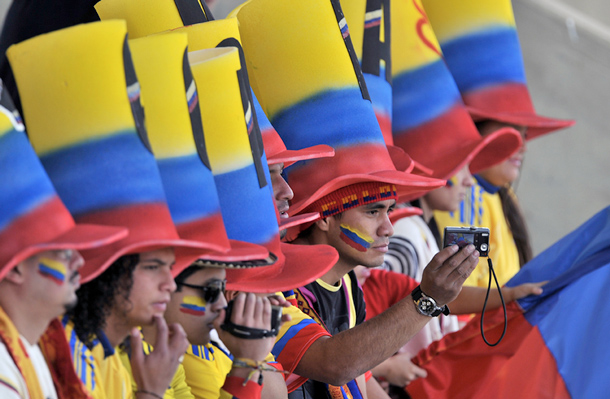
Colombian fans in Chile before the game against Venezuela. Photo: ca2015.com
Group AChile Final group game: |
Group BUruguay Final group game: |
Group CColombia Final group game: |
| Quarter Final 1, June 24: Winner Group A vs Best third place Quarter Final 2, June 25: Second place Group A vs Second place Group C Quarter Final 3, June 26: Winner Group B vs Second best third place Quarter Final 4, June 27: Winner Group C vs Second place Group B Semi Finals: June 29 & 30Final: July 4 |
||
No Ley Seca, but only if you behave, Bogota
To the delight of millions of footie fans, the Bogota city government said last week there will be no Ley Seca, or dry law, during Colombia’s matches at the Copa América tournament – but it comes on the condition that people behave themselves.
City officials and police said it would be okay for bogotanos to enjoy an alcoholic beverage or ten while Los Cafeteros get to work during the 24-day competition in Chile, but it is prohibiting anyone from spraying foam or throwing flour during the festivities.
And if it’s determined that too many people are breaking the rules, then Ley Seca will be enforced.
“We all want to celebrate the triumphs of Team Colombia in peace, and we will only resort to the extreme measure of Ley Seca if the people don’t follow the agreement,” District Secretary Gloria Flórez told local media last week.
All of Colombia’s matches will be shown on big screens in parks and plazas around the city, she added.
By Mark Kennedy
Fast facts….Originally known as the Campeonato Sudamericano de Football, the Copa América is the oldest international football competition. The first edition took place in 1916 between Argentina, Chile, Brazil and Uruguay. It was held as a centennial celebration of Argentina’s independence. The tournament has historically been dominated by Uruguay, who have lifted the trophy 15 times, Argentina (14) and Brazil (8). CONMEBOL, the continent’s football federation, only contains 10 nations, so two national teams are invited to fill the remaining two spots. Only five other nations have participated, none of which have won the competition – Costa Rica, Honduras, USA, Mexico and Japan. This year sees Jamaica competing for the first time. Ecuador goalkeeper Napoleon Medina holds the unfortunate record of most goals conceded in a tournament, letting in a whopping 31 goals in just six games in 1942. He almost broke his own record three years later when he conceded 27. Current hosts Chile have lost the most Copa América games (81) and are one of only three South American teams not to have ever won the cup (along with Venezuela and Ecuador). To celebrate next year’s centenary, a special version of the Copa is to be held in the USA, the first time it has taken place outside of South America. The new trophy will be unveiled at the final of this year’s competition. As well as the ten South American teams, six CONCACAF teams will compete – USA, Jamaica, Mexico, Costa Rica and two teams to be chosen on the basis of their performance at the continental Gold Cup later this year. For every goal scored at the Copa América 2015, Santander bank will donate CLP$2,000,000 (USD$3,150) to Techo Chile. The current format sees three groups of four teams. As well as the top two teams from each group, the two best third place teams progress to the quarter finals. ‘El Pibe’ Valderrama and the current Independiente de Medellin coach Leonel Álvarez are third on the list of Copa América performances, with 32 apiece. There were no red cards shown in the first 13 editions of the tournament. |
Also in our Copa América special be sure to check out our review of the Colombian team’s performance in their first match against Venezuela and the profile on Colombian star Juan Guillermo Cuadrado.

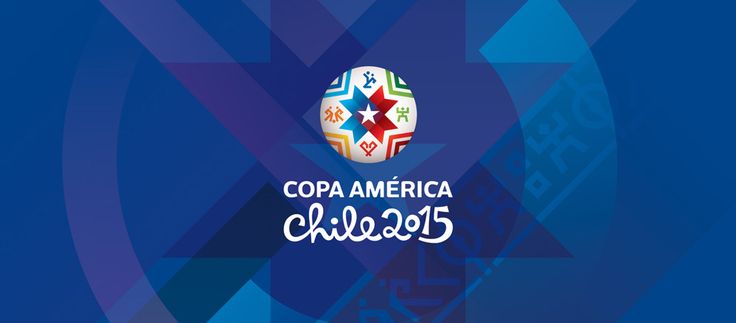
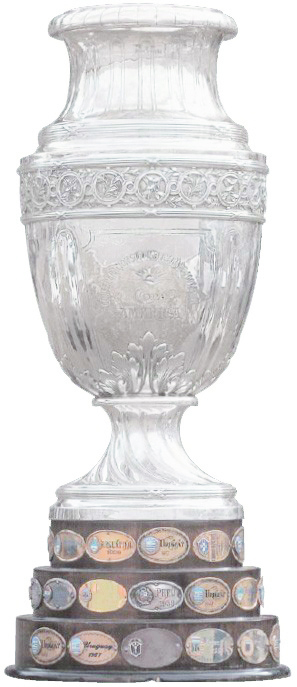 This controversial tournament saw Colombia’s one and only Copa América victory. It was their turn to host, but the months leading up to the event were plagued by security concerns. The armed conflict weighed heavy on potential visitors and the South American football association. At one point authorities announced the cancellation of the cup, with both Venezuela and Brazil offering to step in, but a last minute decision was taken to stick with Colombia.
This controversial tournament saw Colombia’s one and only Copa América victory. It was their turn to host, but the months leading up to the event were plagued by security concerns. The armed conflict weighed heavy on potential visitors and the South American football association. At one point authorities announced the cancellation of the cup, with both Venezuela and Brazil offering to step in, but a last minute decision was taken to stick with Colombia.